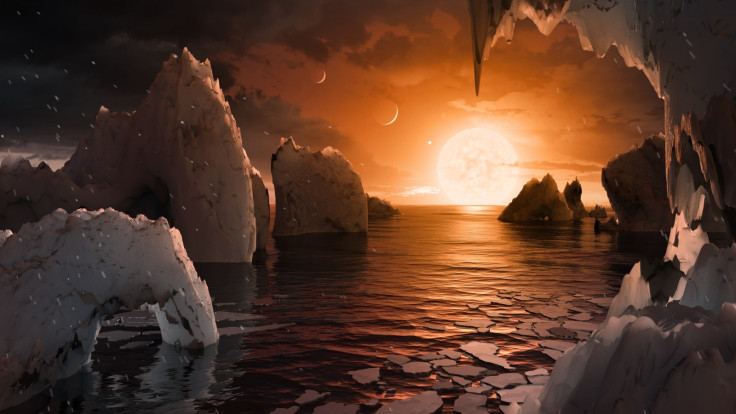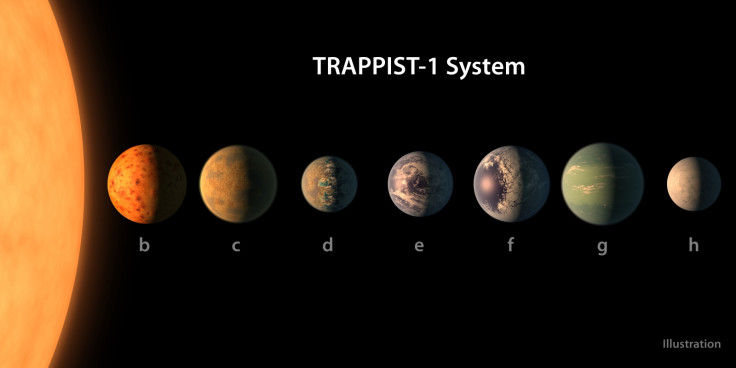What would aliens on Trappist-1 exoplanets be like?
Scientist considers what sort of extraterrestrial life may emerge on newly discovered exoplanets.
The seven potentially habitable exoplanets discovered orbiting the ultra-cool dwarf star Trappist-1 are said to be our best chance at finding evidence of alien life in the near future.
Announcing the discovery in the journal Nature, the team of scientists said three of these planets, Trappist-1e, f and g, have the potential to have a liquid ocean covering them.
To support life (as we know it), these rocky planets would also have to develop the right atmosphere – something we should be able to establish in the coming years.
Without actually visiting the planets or receiving a message from any advanced civilisation that might have emerged, we could never be completely of the presence of life. But if it had evolved – what would it be like?
Lisa Kaltenegger, director of the Carl Sagan Institute at Cornell University, has written two papers currently under review that look at what conditions might be like on the Trappist-1 worlds, and what lifeforms they may support.
"Trappist-1 now holds the record for the most rocky planets in the habitable zone – our solar system only has two – Earth and Mars. Life is a definite possibility on these worlds, but it might look different because there's likely to be very high ultraviolet radiation flux on the surface of these planets," she said.

One of the papers looks at the scenario that the planets have a high UV environment. Different atmospheres would result in different life, she said. "We find that if the star is active, as indicated by the X-ray flux, then planets need an ozone layer to shield their surface from the harsh UV that would sterilise the surface. If the planets around Trappist-1 do not have an ozone layer (like a young Earth), life would need to shelter underground or in an ocean to survive and/or develop strategies to shield itself from the UV, such as biofluorescence."
In the paper, currently being reviewed by the Monthly Notices of the Royal Society, Kaltenegger said that if a dense Earth-like atmosphere that has a protective ozone layer exists, environments would be similar to what we have on Earth. For this reason, she said if ozone is detected in any of the atmospheres, they would make for good target planets in the search for alien life.
But this does not rule out the possibility that life can emerge beneath the surface of a planet that is highly exposed to UV. "Certain radiation-tolerant species have demonstrated an ability to survive full solar UV in space exposure experiments; however, they achieve this by entering a dormant state. Therefore, although life may be able to survive on highly UV-irradiated surfaces like this, it would likely not be able to actively metabolise and complete a life-cycle," the study reads.
"Life could shelter subsurface on such planets, e.g. in an ocean, which would make it harder to detect remotely. If photosynthetic life developed on a highly UV-irradiated planet, the UV defences it would need to employ, such as living under soil layers or underwater, would mean that surface features like the vegetation red edge signature would not exist in surface reflectance spectra.
"However, there may be other detectable surface biosignatures that would be associated with high UV surface environments. Some biological UV-protection methods, such as biofluorescence, could make such a biosphere detectable."
While we will not know if alien life exists on these planets for some time, study author Amaury Triaud discussed what the view might be like from the surface. "Think of the light you see at the end of a sunset, brighter than the moon but dimmer than the sun. However, you would still feel warm because you still get energy from the star," he said.
"The spectacle would be beautiful because every now and again you would see another planet maybe twice as big as the moon in the sky – depending on which star you are on and which you are looking at. On 1f, the star has a diameter that is three times that of the sun seen in the sky. We had a debate about the colour. Originally we thought it would be extremely red like a deep crimson. But in the end the star is so red that most of its light is in the infrared, so we would see something more salmon coloured."

© Copyright IBTimes 2025. All rights reserved.






















